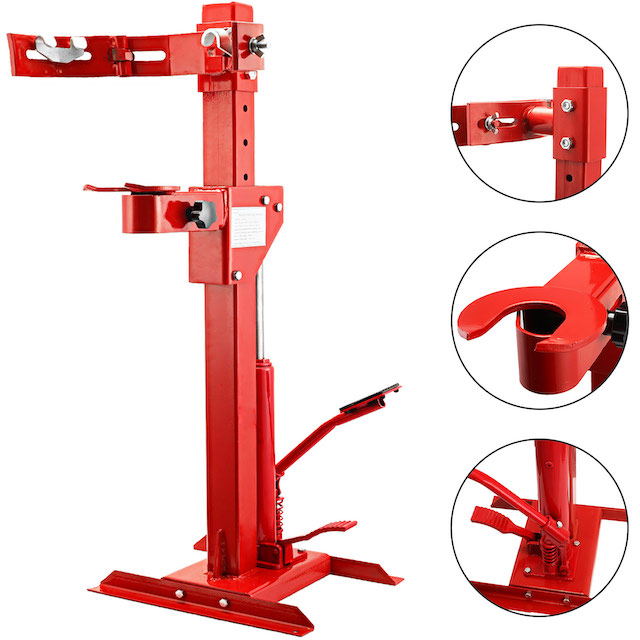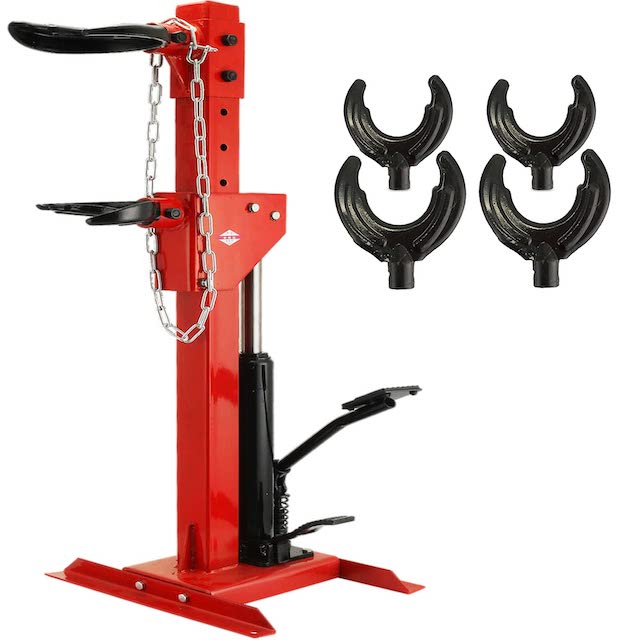Introduction
When it comes to working on suspension systems, having the right tools is crucial. One tool that is essential for any mechanic or DIY enthusiast is the coil spring compressor tool. This tool is designed to safely and effectively compress coil springs, making it easier to remove and install them. In this comprehensive guide, we will explore everything you need to know about coil spring compressor tools, including how they work, the different types available, their uses, safety precautions, and much more.
Part 1: Understanding Coil Spring Compressor Tools
Level 1: What is a coil spring compressor tool?
A coil spring compressor tool is a device that is used to compress coil springs in order to safely remove or install them from a vehicle’s suspension system. It is typically made of heavy-duty steel and features adjustable arms that can accommodate a wide range of spring sizes and types.
Level 2: How does a coil spring compressor tool work?
The basic function of a coil spring compressor tool is to compress the coil spring by tightening the tool’s arms, which reduces the overall size and tension of the spring. This allows for safe removal or installation of the spring without the risk of injury or damage to the vehicle.
Part 2: Types of Coil Spring Compressor Tools
Level 1: Internal vs. External Coil Spring Compressor Tools
There are two main types of coil spring compressor tools: internal and external. Internal compressors are inserted inside the coil spring, while external compressors sit on the outside of the spring. Each type has its own advantages and limitations, so it’s important to choose the right one for the job at hand.
Level 2: Other Variations of Coil Spring Compressor Tools
In addition to internal and external compressors, there are other variations of coil spring compressor tools, such as manual vs. hydraulic, and single-action vs. double-action. Each type is designed for specific applications and can offer different levels of convenience and ease of use.
Part 3: Uses of Coil Spring Compressor Tools
Level 1: Removing and Installing Coil Springs
The primary use of a coil spring compressor tool is to remove and install coil springs in a vehicle’s suspension system. This is often necessary when performing suspension repairs, upgrades, or modifications.
Level 2: Other Applications
Coil spring compressor tools can also be used for other applications, such as compressing valve springs and other types of springs in various mechanical assemblies. Their versatile design makes them a valuable tool for a wide range of automotive and mechanical tasks.
Part 4: Safety Precautions When Using Coil Spring Compressor Tools
Level 1: Proper Handling and Maintenance
It is crucial to handle and maintain coil spring compressor tools properly to ensure safe and effective use. This includes inspecting the tool for any damage or wear before each use, and using it in accordance with the manufacturer’s guidelines.
Level 2: Personal Protective Equipment and Safe Practices
When using a coil spring compressor tool, it’s important to wear appropriate personal protective equipment, such as safety glasses and gloves. Additionally, following safe practices, such as working on a stable surface and releasing the tension on the spring slowly, can help prevent accidents and injuries.
Part 5: Tips for Choosing the Right Coil Spring Compressor Tool
Level 1: Consider the Application
When choosing a coil spring compressor tool, it’s important to consider the specific application and requirements. For example, if you frequently work on a wide range of vehicles, a universal compressor tool may be more suitable than a model designed for a specific make and model.
Level 2: Quality and Durability
Investing in a high-quality coil spring compressor tool is essential for safety and performance. Look for a tool made of heavy-duty materials, with adjustable arms and a secure locking mechanism. Additionally, consider user reviews and ratings to ensure you are getting a durable and reliable tool.
Part 6: Precautions and Safety Measures when using a Coil Spring Compressor Tool
When using a coil spring compressor tool, it is important to take proper precautions to ensure safety. Here are some important safety measures to consider when using a coil spring compressor tool:
- Ensure that the tool is securely mounted and the spring is properly aligned before compressing.
- Never exceed the maximum load capacity of the tool.
- Always wear protective gear such as safety goggles and gloves to prevent injury from flying debris or sharp edges.
- Use caution when releasing the compressed spring to avoid sudden movements and potential injury.
- Keep hands, fingers, and other body parts away from the compressed spring at all times.
- Inspect the tool and the spring for any damage or defects before use.
- Never use a damaged or defective tool to compress a spring.
- Always follow the manufacturer’s instructions and recommendations for safe use of the tool.
- Avoid using the compressor tool in wet or slippery conditions to prevent accidents.
- If in doubt about how to use the tool safely, seek professional advice or assistance.
By following these safety measures and taking proper precautions, you can minimize the risk of injury when using a coil spring compressor tool.
Part 7: Types of Coil Spring Compressor Tools
There are several types of coil spring compressor tools available on the market, each designed for specific applications and spring sizes. Here are some common types of coil spring compressor tools:
- External Coil Spring Compressors – These tools are designed to compress the coil spring from the outside, allowing for easy removal and installation.
- Internal Coil Spring Compressors – These tools are inserted inside the coil spring to compress it from within, often used for tighter spaces or specific vehicle models.
- Hydraulic Coil Spring Compressors – These tools use hydraulic power to compress the spring, offering greater control and ease of use.
- Manual Coil Spring Compressors – These tools require manual effort to compress the spring, often using a ratcheting mechanism for tightening.
- Universal Coil Spring Compressors – These versatile tools are designed to work with a wide range of spring sizes and types, offering flexibility and convenience.
Each type of coil spring compressor tool has its own advantages and limitations, so it is important to choose the right tool for the specific application and spring size.
Part 8: Maintenance and Storage of Coil Spring Compressor Tools
Proper maintenance and storage of coil spring compressor tools are essential to ensure their longevity and performance. Here are some tips for maintaining and storing your compressor tool:
- Regularly inspect the tool for any signs of wear or damage, such as bent or worn components, and replace or repair as needed.
- Keep the tool clean and free from debris, grease, or other contaminants that could affect its performance.
- Store the tool in a dry and secure place, away from moisture, extreme temperatures, or direct sunlight.
- Lubricate moving parts and threads regularly to prevent rust and ensure smooth operation.
- Follow the manufacturer’s recommendations for maintenance and lubrication to prolong the life of the tool.
- Use the tool according to its specified load capacity and application to prevent premature wear and damage.
- When not in use, store the tool in its original packaging or a designated storage case to protect it from damage and keep all components together.
By following these maintenance and storage tips, you can ensure that your coil spring compressor tool remains in good condition and performs reliably for years to come.
Conclusion
A coil spring compressor tool is an indispensable tool for anyone working on suspension systems. Understanding how these tools work, the different types available, their uses, safety precautions, and tips for choosing the right one can help you make informed decisions and use these tools effectively and safely. By following the information in this guide, you can confidently tackle coil spring-related tasks and keep your suspension system in top condition.



